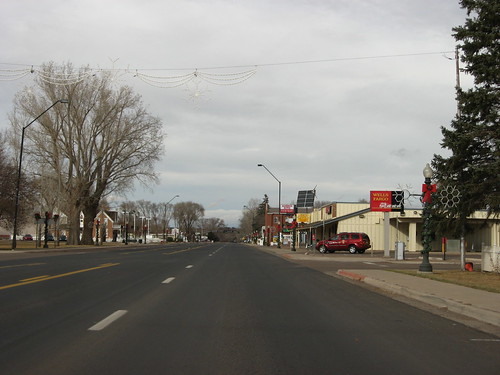Blue Highways: Snowflake, Arizona
Unfolding the Map
Click on Thumbnail for MapWilliam Least Heat-Moon passes through Snowflake, an oddly named town in Arizona - at least I thought so in my teenage ignorance. Where in the heck would a town named Snowflake be located in Arizona? Click on the map thumbnail at right and you'll see!
Book Quote
"Tuesday morning: the country east of Heber was a desert of sagebrush and globe-shaped junipers and shallow washes with signs warning of flash floods. I turned north at Snowflake, founded by Erastus Snow and Bill Flake, and headed toward the twenty-five thousand square miles of Navajo reservation (nearly equal to West Virginia) which occupies most of the northeastern corner of Arizona. The scrub growth disappeared entirely and only the distant outlines of red rock mesas interrupted the emptiness. But for the highway, the land was featureless."
Blue Highways: Part 5, Chapter 2
 Downtown Snowflake, Arizona. Photo by Ken Lund and located on his photostream at Flickr. Click on photo to go to site.
Downtown Snowflake, Arizona. Photo by Ken Lund and located on his photostream at Flickr. Click on photo to go to site.
Snowflake, Arizona
Back when I was in high school, my friend John said that his brother was moving to Snowflake, Arizona to teach school. This was probably about the time that LHM drove through Snowflake on his around the country trip.
As a kid who had left California only once up to that point, I didn't really have a very good sense of geography. I thought I did. I could find Arizona on a map - in fact I loved maps and if given a chance I would peruse them for hours. Whatever I had read about Arizona had always called it a dry and arid state. Every day in the summer it seemed that Phoenix had the highest temperature of the day, usually well over 100 degrees, and sometimes well over 110. Arizona deserts were often referred to in books and magazines. Movies didn't give any other impression than a dry place.
In other words, the idea of a Snowflake, Arizona didn't really fit in with my cognitive map of Arizona. Arizona, to me, was a snowflake's idea of hell. If one could fry an egg on a sidewalk in Arizona, how could anyone associate Arizona with frozen precipitation? I began to assume that Snowflake was in fact an ironic name, a joke name, given by thirsty people with a wish that would never be fulfilled. I would even get a little sarcastic lilt in my voice whenever the subject of John's brother would come up. "You mean, the one in Snowflake, Arizona?" I would ask, drawing out the name of Snowflake a little. To me, it was almost as if John's brother was teaching in Brigadoon, Camelot or some other imaginary, fantastical place.
Of course, a little more knowledge about topography would have been helpful. Growing up at sea level, I never considered elevation and that Arizona could be something more than a flat desert. Having driven through the state a few times now, I am amazed by the varieties of topography and the extent of elevation changes. When I drove to California from Albuquerque through Arizona, we left Albuquerque at 5000 feet and by the time we hit the highest point on Interstate 40 near Flagstaff, Arizona, we were at about 7000 feet above sea level before the long, slow descent to the coast.
Snowflake sits at about 5500 feet, and actually gets cold winters with snow, so I've read. All that sarcasm wasted!
But now, here's the interesting and, in a way, slightly disappointing part to me. Snowflake was not actually named because of its abundance or lack of snowflakes, but because the name is derived by combining the last names of the two Mormon pioneers that founded the town - Erastus Snow and William Flake. On one hand, it makes a good story. On the other hand, however, it once again jars with my cognitive map. A town like Snowflake that gets snow should have a name that reflects the realities of the weather, right? Here's the new irony for me - Snowflake actually makes sense given the town's elevation and weather, even though the name itself had nothing to do with those things at all!
As I sit writing this, I still find it funny and ironic that Snowflake continues to intrigue me all these years later. I graduated from high school almost thirty years ago. My friend John and his family, members of the Mormon Church, have all resettled in Utah and Wyoming. His brother Steve has long since left Snowflake. And yet, when I look at a map, I'm still fascinated by this town name that seems to fit this town, but never quite fit into my own conception of geography and place.
Musical Interlude
While you're looking for more information about Snowflake, if that's what you are really doing, use Claude Thornhill's ethereal composition Snowfall as mood music. I'm sure that Snowflake has this feeling once in awhile!
If you want to know more about Snowflake
City of Snowflake Visitor Information
Snowflake, Arizona Home Page
White Mountains Online: Snowflake
Wikipedia: Snowflake
For science fiction and alien abduction buffs, the vicinity around Snowflake served as the setting for the alleged UFO abduction of Travis Walton. He chronicled his experience in the book The Walton Experience, which was made into a movie: Fire in the Sky.
Next up: Holbrook, Arizona




 Monday, April 4, 2011 at 10:55AM
Monday, April 4, 2011 at 10:55AM


